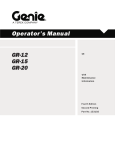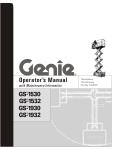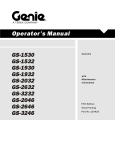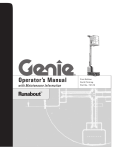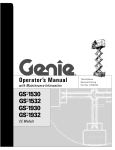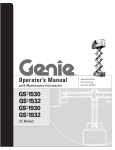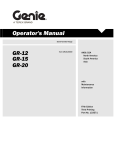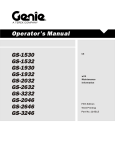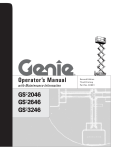Download Genie GR-20 Wheelchair User Manual
Transcript
Operator’s Manual with Maintenance Information CE Models Third Edition Second Printing Part No. 97779 Operator's Manual Third Edition • Second Printing Important Read, understand and obey these safety rules and operating instructions before operating this machine. Only trained and authorized personnel shall be permitted to operate this machine. This manual should be considered a permanent part of your machine and should remain with the machine at all times. If you have any questions, call Genie Industries. Contents Page Safety Rules .............................................................. 1 Legend ....................................................................... 9 Controls .................................................................... 10 Pre-operation Inspection ........................................... 12 Maintenance ............................................................. 14 Function Tests .......................................................... 16 Workplace Inspection ................................................ 20 Operating Instructions ............................................... 21 Transport and Lifting Instructions .............................. 26 Decals ...................................................................... 28 Specifications ........................................................... 32 Copyright © 2000 by Genie Industries Contact us: First Edition: Internet: http://www.genielift.com e-mail: [email protected] Sixth Printing, October 2002 Second Edition: First Printing, August 2004 Third Edition: Second Printing, May 2005 "Genie" is a registered trademark of Genie Industries in the U.S.A. and many other countries. "Runabout" and "GR" are trademarks of Genie Industries. Printed on recycled paper Printed in U.S.A. 2 GR-12 • GR-15 • GR-20 Part No. 97779 Operator's Manual Third Edition • Second Printing Safety Rules Danger Failure to obey the instructions and safety rules in this manual will result in death or serious injury. Do Not Operate Unless: You learn and practice the principles of safe machine operation contained in this operator's manual. 1 Avoid hazardous situations. Know and understand the safety rules before going on to the next section. 2 Always perform a pre-operation inspection. 3 Always perform function tests prior to use. 4 Inspect the workplace. 5 Only use the machine as it was intended. You read, understand and obey the manufacturer's instructions and safety rules— safety and operator's manuals and machine decals. You read, understand and obey employer's safety rules and worksite regulations. You read, understand and obey all applicable governmental regulations. You are properly trained to safely operate the machine. Part No. 97779 GR-12 • GR-15 • GR-20 1 Operator's Manual Third Edition • Second Printing SAFETY RULES Electrocution Hazards Tip-over Hazards This machine is not electrically insulated and will not provide protection from contact with or proximity to electrical current. Occupants, equipment and materials must not exceed the maximum platform capacity. Weight in trays and in each bike rack is part of the total platform load. Maximum capacity - GR-12 and GR-15 Standard platform Work station tray (option) 22 kg Parcel tray (option) 68 kg Maximum occupants Stock Picker platform Maintain safe distances from electrical power lines and apparatus in accordance with applicable governmental regulations and the following chart. Voltage Phase to Phase 0 to 300V Minimum Safe Approach Distance Meters Avoid Contact 300V to 50KV 3.05 50KV to 200KV 4.60 200KV to 350KV 6.10 350KV to 500KV 7.62 500KV to 750KV 10.67 750KV to 1000KV 13.72 227 kg 1 227 kg Adjustable work station tray 68 kg Parcel tray (option) 68 kg Bike rack (option) (each) 20 kg Maximum occupants AWP and fiberglass platform Maximum occupants 1 159 kg 1 Allow for platform movement, electrical line sway or sag and beware of strong or gusty winds. Keep away from the machine if it contacts energized power lines. Personnel on the ground or in the platform must not touch or operate the machine until energized power lines are shut off. Do not operate the machine during lightning or storms. Do not use the machine as a ground for welding. 2 GR-12 • GR-15 • GR-20 Part No. 97779 Operator's Manual Third Edition • Second Printing SAFETY RULES Do not raise the platform unless the machine is on a firm, level surface. Maximum capacity - GR-20 Standard platform Maximum occupants Stock Picker platform 159 kg 1 159 kg Adjustable work station tray 68 kg Bike rack (option) (each) 20 kg Maximum occupants AWP and fiberglass platform Maximum occupants 1 159 kg 1 Do not depend on the tilt alarm as a level indicator. The tilt alarm sounds only when the machine is on a slope. If the tilt alarm sounds: Lower the platform immediately. Move the machine to a firm, level surface. If the tilt alarm sounds when the platform is raised, use extreme caution to lower the platform. Do not alter or disable the limit switches. Do not drive over 0.8 km/h with the platform raised. Use extreme care and slow speeds while driving the machine in the stowed position across uneven terrain, debris, unstable or slippery surfaces and near holes and drop-offs. Do not drive the machine on a slope that exceeds the slope and side slope rating of the machine.Slope rating applies to machines in the stowed position. Maximum slope rating, stowed position 30% (17°) Maximum side slope rating, stowed position 30% (17°) Note: Slope rating is subject to ground conditions and adequate traction. Part No. 97779 GR-12 • GR-15 • GR-20 3 Operator's Manual Third Edition • Second Printing SAFETY RULES Do not use the platform controls to free a platform that is caught, snagged or otherwise prevented from normal motion by an adjacent structure. All personnel must be removed from the platform before attempting to free the platform using the ground controls. Do not operate the machine in strong or gusty winds. Do not increase the surface area of the platform or the load. Increasing the area exposed to the wind will decrease machine stability. Do not push off or pull toward any object outside of the platform. Maximum allowable manual force CE 200 N Do not drive the machine on or near uneven terrain, unstable surfaces or other hazardous conditions with the platform raised. Do not transport tools and materials unless they are evenly distributed and can be safely handled by person(s) in the platform. Do not alter or disable machine components that in any way affect safety and stability. Do not modify or alter an aerial work platform without prior written permission from the manufacturer. Mounting attachments for holding tools or other materials onto the platform, toeboards or guard rail system can increase the weight in the platform and the surface area of the platform or the load. Do not replace items critical to machine stability with items of different weight or specification. Do not use the machine on a moving or mobile surface or vehicle. Do not place or attach fixed or overhanging loads to any part of this machine. Do not raise the mast when wind speeds may exceed 12.5 m/s. If wind speeds exceed 12.5 m/s when the plaform is raised, lower the platform and do not continue to operate the machine. Do not place ladders or scaffolds in the platform or against any part of this machine. Be sure all tires are in good condition, castle nuts are properly tightened and cotter pins are properly installed. 4 GR-12 • GR-15 • GR-20 Part No. 97779 Operator's Manual Third Edition • Second Printing SAFETY RULES Do not use batteries that weigh less than the original equipment. Batteries are used as counterweight and are critical to machine stability. Each battery must weigh 28 kg. Collision Hazards Be aware of limited sight distance and blind spots when driving or operating. Do not use the machine as a crane. Do not push the machine or other objects with the platform. Be aware of the extended platform position when moving the machine. Do not contact adjacent structures with the platform. Do not tie the platform to adjacent structures. Fall Hazards The guard rail system provides fall protection. If occupants of the platform are required to wear personal fall protection equipment (PFPE) due to job site or employer rules, PFPE equipment and its use shall be in accordance with the PFPE manufacturer’s instructions and applicable governmental requirements. Operators must comply with employer, job site and governmental rules regarding use of personal protective quipment. Check the work area for overhead obstructions or other possible hazards. Be aware of crushing hazards when grasping the platform guard rail. Observe and use the color-coded direction arrows Do not sit, stand or climb on the platform guard rails. Maintain a firm footing on the platform floor at all times. on the platform controls and platform decal plate for drive and steer functions. No stunt driving or horseplay while operating a machine. Do not climb down from the platform when raised. Keep the platform floor clear of debris. Lower the platform mid-rail bar or close the platform entry gate before operating. Part No. 97779 GR-12 • GR-15 • GR-20 5 Operator's Manual Third Edition • Second Printing SAFETY RULES Do not lower the platform unless the area below is clear of personnel and obstructions. Explosion and Fire Hazard Do not operate the machine or charge the battery in hazardous locations or locations where potentially flammable or explosive gases or particles may be present. Damaged Machine Hazards Do not use a damaged or malfunctioning machine. Limit travel speed according to the condition of the ground surface, congestion, slope, location of personnel, and any other factors which may cause collision. Do not operate a machine in the path of any crane or moving overhead machinery unless the controls of the crane have been locked out and/or precautions have been taken to prevent any potential collision. Crushing Hazard Use common sense and planning when operating the machine with the controller from the ground. Maintain safe distances between the operator, the machine and fixed objects. Component Damage Hazard Do not use the machine as a ground for welding. 6 Conduct a thorough pre-operation inspection of the machine and test all functions before each work shift. Immediately tag and remove from service a damaged or malfunctioning machine. Be sure all maintenance has been performed as specified in this manual and the appropriate service manual. Be sure all decals are in place and legible. Be sure the operator’s, safety, and responsibilities manuals are complete, legible and in the storage container located on the platform. Bodily Injury Hazard Do not operate the machine with a hydraulic oil or air leak. An air leak or hydraulic leak can penetrate and/or burn skin. Improper contact with components under any cover will cause serious injury. Only trained maintenance personnel should access compartments. Access by the operator is only advised when performing a pre-operation inspection. All compartments must remain closed and secured during operation. GR-12 • GR-15 • GR-20 Part No. 97779 Operator's Manual Third Edition • Second Printing SAFETY RULES Battery Safety Component Damage Hazard Burn Hazards Do not use any battery charger greater than 24V to charge the batteries. Batteries contain acid. Always wear protective clothing and eye wear when working with batteries. Electrocution Hazards Connect the battery charger to a grounded, AC 3-wire electrical outlet only. Inspect daily for damaged cord, cables and wires. Replace damaged items before operating. Avoid spilling or contacting battery acid. Neutralize battery acid spills with baking soda and water. Do not expose the batteries or the charger to water or rain during charging. Explosion Hazards Keep sparks, flames and lighted tobacco away from batteries. Batteries emit an explosive gas. Avoid electrical shock from contact with battery terminals. Remove all rings, watches and other jewelry. Tip-over Hazard Do not use batteries that weigh less than the original equipment. Batteries are used as counterweight and are critical to machine stability. Each battery must weigh 28 kg. Lifting Hazard Use the appropriate number of people and proper lifting techniques when lifting batteries. The battery tray should remain open during the entire charging cycle. Do not contact the battery terminals or the cable clamps with tools that may cause sparks. Part No. 97779 GR-12 • GR-15 • GR-20 7 Operator's Manual Third Edition • Second Printing SAFETY RULES Decal Legend Genie product decals use symbols, color coding and signal words to identify the following: Safety alert symbol—used to alert personnel to potential personal injury hazards. Obey all safety messages that follow this symbol to avoid possible injury or death. Red—used to indicate the presence of an imminently hazardous situation which, if not avoided, will result in death or serious injury. Orange—used to indicate the presence of a potentially hazardous situation which, if not avoided, could result in death or serious injury. Yellow with safety alert symbol— used to indicate the presence of a potentially hazardous situation which, if not avoided, may cause minor or moderate injury. Yellow without safety alert symbol—used to indicate the presence of a potentially hazardous situation which, if not avoided, may result in property damage. Green—used to indicate operation or maintenance information. 8 GR-12 • GR-15 • GR-20 Part No. 97779 Operator's Manual Third Edition • Second Printing Legend 11 Work station tray (if equipped) 19 Bike rack (if equipped) 3 Manual lowering valve 12 Brake release pump knob (under covers) 21 GFCI outlet 4 Transport tie-down 13 Mid-rail entry bar 5 Forklift pocket 14 Adjustable work station tray 6 Battery charger display 15 Platform controls 7 Covers 16 Dual-entry gate 8 Ground controls 17 Lanyard anchorage 9 Hydraulic oil level indicator 26 Platform extension release pedal 18 Parcel tray (if equipped) 27 Platform extension entry gate 1 Pothole guard 2 Non-steer tire 10 Power to platform/battery charger connection for optional inverter Part No. 97779 GR-12 • GR-15 • GR-20 20 Mast 22 Manual storage container 23 Battery compartment cover 24 Battery cover latch 25 Steer tire 9 Operator's Manual Third Edition • Second Printing Controls Platform Controls 1 Red Emergency Stop button 2 LED diagnostic readout / Platform overload indicator / Battery charge indicator 5 Proportional control handle and function enable switch for lift and drive functions 6 Thumb rocker switch for steer functions 3 Lift function select button 7 Drive speed button 4 Horn button (if equipped) 8 Drive function select button 10 GR-12 • GR-15 • GR-20 Part No. 97779 Operator's Manual Third Edition • Second Printing CONTROLS 1 2 00009.9 3 4 STOP 5 Ground Control Panel 1 2 3 4 5 7 amp breaker for electrical circuits Key switch for platform/off/ground selection Hour meter Platform up/down toggle switch Red Emergency Stop button Part No. 97779 GR-12 • GR-15 • GR-20 11 Operator's Manual Third Edition • Second Printing Pre-operation Inspection Fundamentals It is the responsibility of the operator to perform a pre-operation inspection and routine maintenance. Do Not Operate Unless: You learn and practice the principles of safe machine operation contained in this operator's manual. 1 Avoid hazardous situations. 2 Always perform a pre-operation inspection. Know and understand the pre-operation inspection before going on to the next section. 3 Always perform function tests prior to use. 4 Inspect the workplace. 5 Only use the machine as it was intended. The pre-operation inspection is a visual inspection performed by the operator prior to each work shift. The inspection is designed to discover if anything is apparently wrong with a machine before the operator performs the function tests. The pre-operation inspection also serves to determine if routine maintenance procedures are required. Only routine maintenance items specified in this manual may be performed by the operator. Refer to the list on the next page and check each of the items. If damage or any unauthorized variation from factory delivered condition is discovered, the machine must be tagged and removed from service. Repairs to the machine may only be made by a qualified service technician, according to the manufacturer's specifications. After repairs are completed, the operator must perform a pre-operation inspection again before going on to the function tests. Scheduled maintenance inspections shall be performed by qualified service technicians, according to the manufacturer's specifications and the requirements listed in the responsibilities manual. 12 GR-12 • GR-15 • GR-20 Part No. 97779 Operator's Manual Third Edition • Second Printing PRE-OPERATION INSPECTION Check the entire machine for: Pre-operation Inspection o Be sure that the operator's, safety and responsibilities manuals are complete, legible and in the storage container located on the platform. o Be sure that all decals are legible and in place. See Decals section. o Cracks in welds or structural components o Dents or damage to the machine o Be sure that all structural and other critical components are present and all associated fasteners and pins are in place and properly tightened. o Check for hydraulic oil leaks and proper oil level. See Maintenance section. o Check for battery fluid leaks and proper fluid level. Add distilled water if needed. See Maintenance section. Check the following components or areas for damage, improperly installed or missing parts and unauthorized modifications: o Electrical components, wiring and electrical cables o Hydraulic power unit, tank, hoses, fittings, cylinders and manifolds o Battery pack and connections o Drive motors o Tires and wheels o Limit switches and alarms o Nuts, bolts and other fasteners o Platform entry mid-rail bar or gate o Sequencing cables and pulleys o Platform extension (if equipped) o Work trays and bike racks (if equipped) o Mast columns and counterweight o Platform controls o Brake release components Part No. 97779 GR-12 • GR-15 • GR-20 13 Operator's Manual Third Edition • Second Printing Maintenance Check the Hydraulic Oil Level Maintaining the hydraulic oil at the proper level is essential to safe machine operation. Improper hydraulic oil levels can damage hydraulic components. Daily checks allow the inspector to identify changes in oil level that might indicate the presence of hydraulic system problems. Observe and Obey: Only routine maintenance items specified in this manual shall be performed by the operator. Scheduled maintenance inspections shall be completed by qualified service technicians, according to the manufacturer's specifications and the requirements specified in the responsibilities manual. Perform this procedure with the platform in the stowed position. 1 Visually inspect the hydraulic oil level through the indicator at the back of the machine. Result: The hydraulic oil level should be visible. 2 Add oil if necessary. Do not overfill. Hydraulic oil specifications Hydraulic oil type Maintenance Symbols Legend Chevron Rykon Premium MV equivalent The following symbols have been used in this manual to help communicate the intent of the instructions. When one or more of the symbols appear at the beginning of a maintenance procedure, it conveys the meaning below. Indicates that tools will be required to perform this procedure. Indicates that new parts will be required to perform this procedure. 14 GR-12 • GR-15 • GR-20 Part No. 97779 Operator's Manual Third Edition • Second Printing MAINTENANCE 7 Remove the battery vent caps. Check the Batteries Proper battery condition is essential to good performance and operational safety. Improper fluid levels or damaged cables and connections can result in component damage and hazardous conditions. This procedure does not need to be performed on machines with sealed or maintenance - free batteries. Electrocution hazard. Contact with hot or live circuits could result in death or serious injury. Remove all rings, watches and other jewelry. 8 Check the battery acid level. If needed, replenish with distilled water to the bottom of the battery fill tube. Do not overfill. 9 Install the vent caps. 10 Raise the platform and lower the cover. Scheduled Maintenance Maintenance performed quarterly, annually and every two years must be completed by a person trained and qualified to perform maintenance on this machine according to the procedures found in the service manual for this machine. Machines that have been out of service for more than three months must receive the quarterly inspection before they are put back into service. Bodily injury hazard. Batteries contain acid. Avoid spilling or contacting battery acid. Neutralize battery acid spills with baking soda and water. Perform this test after fully charging the batteries. 1 Put on protective clothing and eye wear. 2 Raise the platform approximately 1.5 m. 3 Open the battery cover. Rest the cover against the chassis. 4 Lower the platform until the mast just contacts the battery cover. Crushing hazard. Keep hands clear of the battery cover when lowering the platform. 5 Turn the key switch to the off position. 6 Be sure that the battery cable connections are tight and free of corrosion. Part No. 97779 GR-12 • GR-15 • GR-20 15 Operator's Manual Third Edition • Second Printing Function Tests Fundamentals The function tests are designed to discover any malfunctions before the machine is put into service. The operator must follow the step-by-step instructions to test all machine functions. Do Not Operate Unless: You learn and practice the principles of safe machine operation contained in this operator's manual. 1 Avoid hazardous situations. A malfunctioning machine must never be used. If malfunctions are discovered, the machine must be tagged and removed from service. Repairs to the machine may only be made by a qualified service technician, according to the manufacturer's specifications. After repairs are completed, the operator must perform a pre-operation inspection and function tests again before putting the machine into service. 2 Always perform a pre-operation inspection. 3 Always perform function tests prior to use. Know and understand the function tests before going on to the next section. 4 Inspect the workplace. 5 Only use the machine as it was intended. 16 GR-12 • GR-15 • GR-20 Part No. 97779 Operator's Manual Third Edition • Second Printing FUNCTION TESTS 1 Select a test area that is firm, level and free of obstruction. At the Platform Controls Test Emergency Stop 2 Be sure the battery pack is connected. 13 Push in the platform red Emergency Stop button to the off position. At the Ground Controls 3 Pull out the platform and ground red Emergency Stop buttons to the on position. 4 Turn the key switch to ground control. 5 Observe the diagnostic LED readout on the platform controls. Result: The LED should look like the picture at right. Result: No functions should operate. Test the Horn 14 Pull out the red Emergency Stop button to the on position. 15 Push the horn button. Result: The horn should sound. Test Emergency Stop Test the Function Enable Switch 6 Push in the ground red Emergency Stop button to the off position. 16 Do not press the function enable switch on the control handle. Result: No functions should operate. 7 Pull out the red Emergency Stop button to the on position. Test the Up/Down Functions 17 Slowly move the control handle in the direction indicated by the blue arrow, then in the direction indicated by the yellow arrow. Result: No functions should operate. Test the Up/Down Functions 8 Activate the up function. 18 Press the lift function select button. Result: The platform should raise. 9 Activate the down function. Result: The platform should lower. The descent alarm should sound while the platform is lowering. Test Manual Lowering 10 Activate the up function and raise the platform approximately 60 cm. 11 Pull the manual lowering knob located at the base of the machine below the charger. 19 Press and hold the function enable switch on the control handle. 20 Slowly move the control handle in the direction indicated by the blue arrow. Result: The platform should raise. 21 Release the control handle. Result: The platform should stop raising. Result: The platform should lower. The descent alarm will not sound. 12 Turn the key switch to platform control. Part No. 97779 GR-12 • GR-15 • GR-20 17 Operator's Manual Third Edition • Second Printing FUNCTION TESTS 22 Press and hold the function enable switch. Slowly move the control handle in the direction indicated by the yellow arrow. Result: The platform should lower. The descent alarm should sound while the platform is lowering. Test the Steering Note: When performing the steer and drive function tests, stand in the platform facing the steer end of the machine. Test Drive and Braking 27 Press and hold the function enable switch on the control handle. 28 Slowly move the control handle in the direction indicated by the blue arrow on the control panel until the machine begins to move, then return the handle to the center position. Result: The machine should move in the direction that the blue arrow points on the control panel, then come to an abrupt stop. 29 Slowly move the control handle in the direction indicated by the yellow arrow on the control panel until the machine begins to move, then return the handle to the center position. 23 Press the drive function select switch. 24 Press and hold the function enable switch on the control handle. 25 Press the thumb rocker switch on top of the control handle in the direction indicated by the blue triangle on the control panel. Result: The steer wheels should turn in the direction that the blue triangle points on the control panel. 26 Press the thumb rocker switch in the direction indicated by the yellow triangle on the control panel. Result: The steer wheels should turn in the direction that the yellow triangle points on the control panel. Result: The machine should move in the direction that the yellow arrow points on the control panel, then come to an abrupt stop. Note: The brakes must be able to hold the machine on any slope it is able to climb. Test the Tilt Sensor Operation Note: Perform this test from the ground with the platform controller. Do not stand in the platform. 30 Press the lift function select button. 31 Fully lower the platform. 32 Place a 2x4 or similar piece of wood in front of each wheel on one side of the machine. 33 Press the drive function select button. 34 Drive the machine up onto both pieces of wood. 35 Press the lift function select button. 18 GR-12 • GR-15 • GR-20 Part No. 97779 Operator's Manual Third Edition • Second Printing FUNCTION TESTS 36 Raise the platform. Test the Pothole Guards Result: Before the platform is raised approximately 30 cm, the lift function should stop, an alarm should sound and the LED readout should display LL. Note: The pothole guards should automatically deploy when the platform is raised. The pothole guards activate another limit switch which allows the machine to continue to function. If the pothole guards do not deploy, an alarm sounds and the machine will not drive. 37 Press the drive function select button. 38 Press and hold the function enable switch and slowly move the control handle in the direction indicated by the blue arrow, then in the direction indicated by the yellow arrow. Result: The drive function should not work in either direction. 39 Lower the platform and drive the machine off both pieces of wood. 44 Raise the platform. Result: When the platform is raised 1.2 m from the ground, the pothole guards should deploy. 45 Press on the pothole guards on one side, and then the other. Result: The pothole guards should not move. 46 Lower the platform. Result: The pothole guards should return to the stowed position. Test Limited Drive Speed 40 Press the lift function select button. 41 Press and hold the function enable switch on the control handle. Raise the platform approximately 60 cm from the ground. 42 Press the drive function select button. 43 Press and hold the function enable switch on the control handle. Slowly move the control handle to the full drive position. 47 Place a 2x4 or similar piece of wood under a pothole guard. Raise the platform. Result: Before the platform is raised 2.1 m from the ground, an alarm should sound and the drive function should not work. 48 Lower the platform and remove the 2x4. Result: The maximum achievable drive speed with the platform raised should not exceed 20 cm per second. If the drive speed with the platform raised exceeds 20 cm per second, immediately tag and remove the machine from service. Part No. 97779 GR-12 • GR-15 • GR-20 19 Operator's Manual Third Edition • Second Printing Workplace Inspection Workplace Inspection Be aware of and avoid the following hazardous situations: Do Not Operate Unless: You learn and practice the principles of safe machine operation contained in this operator's manual. 1 Avoid hazardous situations. 2 Always perform a pre-operation inspection. 3 Always perform function tests prior to use. 4 Inspect the workplace. Know and understand the workplace inspection before going on to the next section. · drop-offs or holes · bumps, floor obstructions or debris · sloped surfaces · unstable or slippery surfaces · overhead obstructions and high voltage conductors · hazardous locations · inadequate surface support to withstand all load forces imposed by the machine · wind and weather conditions · the presence of unauthorized personnel · other possible unsafe conditions 5 Only use the machine as it was intended. Fundamentals The workplace inspection helps the operator determine if the workplace is suitable for safe machine operation. It should be performed by the operator prior to moving the machine to the workplace. It is the operator's responsibility to read and remember the workplace hazards, then watch for and avoid them while moving, setting up and operating the machine. 20 GR-12 • GR-15 • GR-20 Part No. 97779 Operator's Manual Third Edition • Second Printing Operating Instructions Fundamentals The Operating Instructions section provides instructions for each aspect of machine operation. It is the operator's responsibility to follow all the safety rules and instructions in the operator's, safety and responsibilities manuals. Using the machine for anything other than lifting personnel, along with their tools and materials, to an aerial work site is unsafe and dangerous. Do Not Operate Unless: You learn and practice the principles of safe machine operation contained in this operator's manual. 1 Avoid hazardous situations. 2 Always perform a pre-operation inspection. 3 Always perform function tests prior to use. 4 Inspect the workplace. Only trained and authorized personnel should be permitted to operate a machine. If more than one operator is expected to use a machine at different times in the same work shift, they must all be qualified operators and are all expected to follow all safety rules and instructions in the operator's, safety and responsibilities manuals. That means every new operator should perform a pre-operation inspection, function tests, and a workplace inspection before using the machine. 5 Only use the machine as it was intended. Part No. 97779 GR-12 • GR-15 • GR-20 21 Operator's Manual Third Edition • Second Printing OPERATING INSTRUCTIONS Emergency Stop To Position Platform Push in the red Emergency Stop button to the off position at the ground or platform controls to stop all machine functions. 1 Press the lift function select button. Repair any function that operates when either red Emergency Stop button is pushed in. Auxiliary Lowering 2 Press and hold the function enable switch on the control handle. 3 Move the control handle according to the markings on the control panel. To Steer 1 Pull the auxiliary lowering knob. Operation From Ground 1 Press the drive function select button. 1 Turn the key switch to ground control. 2 Press and hold the function enable switch on the control handle. 2 Pull out both ground and platform red Emergency Stop buttons to the on position. 3 Be sure the battery pack is connected before operating the machine. 3 Turn the steer wheels with the thumb rocker switch located on the top of the control handle. To Drive To Position Platform 1 Press the drive function select button. 1 Move the up/down toggle switch according to the markings on the control panel. 2 Press and hold the function enable switch on the control handle. Drive and steer functions are not available from the ground controls. 3 Increase speed: Slowly move the control handle off center. Operation From Platform 1 Turn the key switch to platform control. 2 Pull out the ground and platform red Emergency Stop buttons to the on position. 3 Be sure the battery pack is connected before operating the machine. Decrease speed: Slowly move the control handle toward center. Stop: Return the control handle to center or release the function enable switch. Use the color-coded direction arrows on the platform controls and on the platform to identify the direction the machine will travel. Machine travel speed is restricted when the platform is raised. 22 GR-12 • GR-15 • GR-20 Part No. 97779 Operator's Manual Third Edition • Second Printing OPERATING INSTRUCTIONS To Reduce Drive Speed To determine the slope grade: The drive controls can operate in two different drive speed modes. When the drive speed button light is on, slow drive speed mode is active. When the button light is off, fast drive speed mode is active. Measure the slope with a digital inclinometer OR use the following procedure. Press the drive speed button to select the desired drive speed. You will need: carpenter’s level straight piece of wood, at least 1 m long tape measure Driving on a slope Lay the piece of wood on the slope. Determine the slope and side slope ratings for the machine and determine the slope grade. At downhill end, lay the level on the top edge of the piece of wood and lift the end until the piece of wood is level. Maximum slope rating, stowed position: 30% (17°) Maximum side slope rating, stowed position: 30% (17°) Note: Slope rating is subject to ground conditions and adequate traction. While holding the piece of wood level, measure the distance from the bottom of the piece of wood to the ground. Divide the tape measure distance (rise) by the length of the piece of wood (run) and multiply by 100. Example: run Press the drive speed button to the fast drive speed mode. rise Run = 3.6 m Rise = 0.3 m 0.3 m ÷ 3.6 m = 0.083 x 100 = 8.3% If the slope exceeds the maximum slope or side slope rating, the machine must be winched or transported up or down the slope. See Transport and Lifting section. Part No. 97779 GR-12 • GR-15 • GR-20 23 Operator's Manual Third Edition • Second Printing OPERATING INSTRUCTIONS Error Indicator display Battery Level Indicator If the LED diagnostic readout displays an error code, such as LL, push in and pull out the red Emergency Stop button to reset the system. To Extend and Retract Platform (if equipped) 1 Step on the platform extension release pedal. 2 Grasp the platform guard rails carefully and push to extend the platform. 3 Step on the platform extension release pedal and pull the guard rails to retract the platform. Operation From Ground with Controller Maintain safe distances between the operator, machine and fixed objects. Be aware of the direction the machine will travel when using the controller. Platform Overload Flashing OL in the LED diagnostic readout indicates the platform is overloaded and no functions will operate. An alarm will sound. Full Low Use the LED diagnostic readout to determine the battery level. Fall Protection Personal fall protection equipment (PFPE) is not required when operating this machine. If PFPE is required by job site or employer rules, the following shall apply: All PFPE must comply with applicable governmental regulations and must be inspected and used in accordance with the manufacturer’s instructions. After Each Use 1 Select a safe parking location—firm level surface, clear of obstruction and traffic. 2 Lower the platform. 3 Turn the key switch to the off position and remove the key to secure from unauthorized use. 4 Chock the wheels. 5 Charge the batteries. 1 Push in the Red Emergency stop button to the off position. 2 Remove the weight from the platform. 3 Pull out the Red Emergency stop button to the on position. 24 GR-12 • GR-15 • GR-20 Part No. 97779 Operator's Manual Third Edition • Second Printing OPERATING INSTRUCTIONS Standard Batteries 1 Put on protective clothing and eye wear. 2 Raise the platform approximately 1.5 m. 3 Open the battery cover. Rest the cover against the chassis. Battery and Charger Instructions 4 Lower the platform until the mast just contacts the battery cover. Observe and Obey: Do not use an external charger or booster battery. Charge the battery in a well-ventilated area. Use proper AC input voltage for charging as indicated on the machine. Use only a Genie authorized battery and charger. Crushing hazard. Keep hands clear of the battery cover when lowering the platform. 5 Turn the key switch to the off position. 6 Be sure that the battery cable connections are tight and free of corrosion. 7 Remove the battery vent caps and check the battery acid level. If necessary, add only enough distilled water to cover the plates. Do not overfill prior to the charge cycle. 8 Replace the battery vent caps. To Charge Batteries 9 Connect the battery charger to a grounded AC circuit. Maintenance - free batteries 1 Connect the battery charger to a grounded AC circuit. 2 The charger will indicate when the battery is fully charged. 10 The charger will indicate when the battery is fully charged. 11 Check the battery acid level when the charging cycle is complete. Replenish with distilled water to the bottom of the fill tube. Do not overfill. 12 Raise the platform and lower the cover. Part No. 97779 GR-12 • GR-15 • GR-20 25 Operator's Manual Third Edition • Second Printing Transport and Lifting Instructions Brake Release Operation 1 Chock the wheels to prevent the machine from rolling. 2 Be sure the winch line is properly secured to the drive chassis tie points and the path is clear of all obstructions. Observe and Obey: Common sense and planning must be applied to control the movement of the machine when lifting it with a crane or forklift. The transport vehicle must be parked on a level surface. The transport vehicle must be secured to prevent rolling while the machine is being loaded. Be sure the vehicle capacity, loading surfaces and chains or straps are sufficient to withstand the machine weight. See the serial plate for the machine weight. 3 Push in the black brake release knob to open the brake valve. 4 Pump the red brake release pump knob After the machine is loaded: 1 Push in both ground and platform red Emergency Stop buttons to the off position. 2 Turn the key switch to the off position. 3 Chock the wheels to prevent the machine from rolling. 4 Push the brake release switch closed to reset the brakes. The machine must be on a level surface or secured before releasing the brakes. Brake Release Switch Do not drive the machine on a slope that exceeds the slope or side slope rating. See Driving on a Slope in the Operating Instructions section. If the slope of the transport vehicle bed exceeds the maximum slope rating, the machine must be loaded and unloaded using a winch as described. 26 GR-12 • GR-15 • GR-20 Part No. 97779 Operator's Manual Third Edition • Second Printing TRANSPORT AND LIFTING INSTRUCTIONS Loading the Machine With a Crane Securing to Truck or Trailer for Transit Use the lifting eye mounted on the rear mast column. Always chock the machine wheels in preparation for transport. Make sure the mast is fully lowered. Turn the key switch to the off position and remove the key before transporting. Inspect the machine and remove any loose or unsecured items. Always place the lifting hook through the lifting eye so that it points away from the machine. Inspect the entire machine for loose or unsecured items. Securing the Chassis Use the tie-down points on the chassis for anchoring down to the transport surface. Use chains or straps of ample load capacity. Use a minimum of 4 chains. Adjust the rigging to prevent damage to the chains. Truck bed Part No. 97779 1 3 2 4 GR-12 • GR-15 • GR-20 27 Operator's Manual Third Edition • Second Printing Decals Inspection for Decals with Symbols Standard and AWP Platforms Determine whether the decals on your machine have words or symbols. Use the appropriate inspection to verify that all decals are legible and in place. Part No. Description Quantity Part No. Description Quantity 28171 Label - No Smoking 1 82836 Label - Manual Lowering 1 28174 Label - Power to Platform, 230 V 2 97772 Overlay - Platform Controls 1 28235 Label - Power to Platform, 115 V 2 97776 Ground Control Panel 1 40434 Label - Lanyard Anchorage 1 97810 Cosmetic - Genie GR-12 2 43658 Label - Power to Charger, 230 V 1 97811 Cosmetic - Genie GR-15 2 44980 Label - Power to Charger, 115 V 1 97812 Cosmetic - Genie GR-20 2 52475 Label - Transport Tie-down 3 97813 Label - Wheel Load, GR-20 4 72086 Label - Lifting Eye 1 97815 72143 Label - Emergency Stop 1 Label - Lower Midrail (models with sliding midrail entry option) 1 72184 Cosmetic - Genie Runabout 2 72188 Label - Directional Arrows 2 Danger - Max Capacity 227 kg, GR-12, GR-15 (standard platform) 1 82481 Danger - Battery Safety 1 97833 Danger - Max Capacity 159 kg, GR-20 1 82487 Label - Read the Manual 2 97873 Danger - Max Capacity, Workstation Tray 22 kg, GR-12, GR-15 1 82495 Danger - Brake Release Safety & Operating Instructions 97882 Label - Wheel Load, GR-12 4 1 82614 Danger - Collision Hazard 1 97883 Label - Wheel Load, GR-15 4 82666 Label - Forklift Pocket 2 97898 Danger - Max Capacity, Parcel Tray 68 kg, GR-12, GR-15 1 82829 Danger - Electrocution Hazard 1 Danger - Safety Chock 1 82830 Danger - Max Side Force 200 N 1 82835 Danger - Max Capacity 159 kg (models with AWP and fiberglass platform) 1 28 97832 97899 GR-12 • GR-15 • GR-20 Part No. 97779 Operator's Manual Third Edition • Second Printing DECALS Shading indicates decal is hidden from view, i.e., under covers. Note: Platform decals may be in diffferent locations on optional AWP and fiberglass platforms. Part No. 97779 GR-12 • GR-15 • GR-20 29 Operator's Manual Third Edition • Second Printing DECALS Inspection for Decals with Symbols Stock Picker Platform Determine whether the decals on your machine have words or symbols. Use the appropriate inspection to verify that all decals are legible and in place. Part No. Description Quantity Part No. Description Quantity 28171 Label - No Smoking 1 82836 Label - Manual Lowering 1 28174 Label - Power to Platform, 230 V 2 97772 Overlay - Platform Controls 1 28235 Label - Power to Platform, 115 V 2 97776 Ground Control Panel 1 40434 Label - Lanyard Anchorage 1 97810 Cosmetic - Genie GR-12 2 43658 Label - Power to Charger, 230 V 1 97811 Cosmetic - Genie GR-15 2 44980 Label - Power to Charger, 115 V 1 97812 Cosmetic - Genie GR-20 2 52475 Label - Transport Tie-down 3 97813 Label - Wheel Load, GR-20 4 72086 Label - Lifting Eye 1 97834 72143 Label - Emergency Stop 1 Danger - Max Capacity, 227 kg, GR-12, GR-15 1 72184 Cosmetic - Genie Runabout 1 97835 Danger - Max Capacity, 159 kg, GR-20 1 72188 Label - Directional Arrows 2 97871 82481 Danger - Battery Safety 1 Danger - Max Capacity, Bike Rack, GR-12, GR-15 1 82487 Label - Read the Manual 2 Danger - Max Capacity, Bike Rack, GR-20 1 82495 Danger - Brake Release Safety & Operating Instructions 97882 Label - Wheel Load, GR-12 4 1 82614 Danger - Collision Hazard 1 97883 Label - Wheel Load, GR-15 4 82666 Label - Forklift Pocket 2 97898 Danger - Max Capacity, Parcel Tray 68 kg, GR-12, GR-15 1 82829 Danger - Electrocution Hazard 1 Danger - Safety Chock 1 82830 Danger - Max Side Force 200 N 1 30 97872 97899 GR-12 • GR-15 • GR-20 Part No. 97779 Operator's Manual Third Edition • Second Printing DECALS Shading indicates decal is hidden from view, i.e., under covers. Part No. 97779 GR-12 • GR-15 • GR-20 31 Operator's Manual Third Edition • Second Printing Specifications GR-12 Power source 4 Batteries, 6V 225AH Height, working maximum 5.31 m Controls Height, platform maximum 3.48 m AC outlet in platform Height, stowed maximum 1.72 m Tire size Height, stowed maximum standard platform with work station tray 1.62 m Height, stowed maximum stock picker platform with work station tray 1.62 m Airborne noise emissions 70 dB Maximum sound level at normal operating workstations (A-weighted) Height, stowed maximum stock picker platform with bike racks 1.60 m Width 75 cm Maximum side slope rating 30% (17°) Note: Slope rating is subject to ground conditions and adequate traction. Drive speeds Length with standard platform optional platform extension extended 1.85 m Stowed, maximum Length with stock picker platform including adjustable tray 1.87 m Platform raised, maximum Length with stock picker platform including adjustable tray and work station tray 1.91 m Floor loading information Maximum capacity, standard platform 227 kg Maximum capacity, AWP and fiberglass platform 159 kg Maximum capacity, stock picker platform 227 kg Turning radius (inside) Turning radius (outside) Tire load, maximum Tire contact pressure Occupied floor pressure 4.0 km/h 12.2 m/10.9 sec 0.8 km/h 12.5 m/55 sec 464 kg 11.06 kg/cm2 1085 kPA 936 kg/m2 9.18 kPA Note: Floor loading information is approximate and does not incorporate different option configurations. It should be used only with adequate safety factors. 0 cm 78.7 cm Weight See Serial Label (Machine weights vary with option configurations) 32 25.4 x 7.6 x 2.5 cm 30% (17°) 1.35 m 12.5 m/s Standard Maximum slope rating, stowed position Length, stowed Maximum wind speed Proportional Continuous improvement of our products is a Genie policy. Product specifications are subject to change without notice or obligation. GR-12 • GR-15 • GR-20 Part No. 97779 Operator's Manual Third Edition • Second Printing SPECIFICATIONS GR-15 Power source 4 Batteries, 6V 225AH Height, working maximum 6.30 m Controls Height, platform maximum 4.47 m AC outlet in platform Height, stowed maximum 1.72 m Tire size Height, stowed maximum standard platform with work station tray 1.62 m Height, stowed maximum stock picker platform with work station tray 1.62 m Airborne noise emissions 70 dB Maximum sound level at normal operating workstations (A-weighted) Height, stowed maximum stock picker platform with bike racks 1.97 m Width 75 cm Maximum side slope rating 30% (17°) Note: Slope rating is subject to ground conditions and adequate traction. Drive speeds Length with standard platform optional platform extension extended 1.85 m Stowed, maximum Length with stock picker platform including adjustable tray 1.87 m Platform raised, maximum Length with stock picker platform including adjustable tray and work station tray 1.91 m Floor loading information Maximum capacity, standard platform 227 kg Maximum capacity, AWP and fiberglass platform 159 kg Maximum capacity, stock picker platform 227 kg Turning radius (inside) Turning radius (outside) Tire load, maximum 4.0 km/h 12.2 m/10.9 sec 0.8 km/h 12.5 m/55 sec 606 kg Tire contact pressure 14.4 kg/cm2 1418 kPA Occupied floor pressure 1210 kg/m2 11.87 kPA Note: Floor loading information is approximate and does not incorporate different option configurations. It should be used only with adequate safety factors. 0 cm 78.7 cm Weight See Serial Label (Machine weights vary with option configurations) Part No. 97779 25.4 x 7.6 x 2.5 cm 30% (17°) 1.35 m 12.5 m/s Standard Maximum slope rating, stowed position Length, stowed Maximum wind speed Proportional Continuous improvement of our products is a Genie policy. Product specifications are subject to change without notice or obligation. GR-12 • GR-15 • GR-20 33 Operator's Manual Third Edition • Second Printing SPECIFICATIONS GR-20 AC outlet in platform Standard Height, working maximum 7.90 m Tire size Height, platform maximum 6.07 m Height, stowed maximum 1.98 m Airborne noise emissions 70 dB Maximum sound level at normal operating workstations (A-weighted) Height, stowed maximum stock picker platform with bike racks 1.60 m Maximum slope rating, stowed position 30% (17°) Maximum side slope rating 30% (17°) Width 80 cm 25.4 x 7.6 x 2.5 cm Length, stowed 1.42 m Note: Slope rating is subject to ground conditions and adequate traction. Length with standard platform optional platform extension extended 1.92 m Stowed, maximum Length with stock picker platform including adjustable tray 1.94 m Platform raised, maximum Maximum capacity, standard platform 159 kg Floor Loading Information Maximum capacity, AWP and fiberglass platform 159 kg Maximum capacity, stock picker platform 159 kg Maximum wind speed Turning radius (inside) Turning radius (outside) Tire Load, maximum Tire Contact Pressure Occupied Floor Pressure 4.0 km/h 12.2 m/10.9 sec 0.8 km/h 12.5 m/55 sec 553 kg 13 kg/cm2 1292.76 kPA 1180 kg/m2 11.57 kPA 45 km/h 0 cm 78.7 cm Note: Floor loading information is approximate and does not incorporate different option configurations. It should be used only with adequate safety factors. Weight See Serial Label (Machine weights vary with option configurations) Power source Controls 34 4 Batteries, 6V 225AH Proportional Continuous improvement of our products is a Genie policy. Product specifications are subject to change without notice or obligation. GR-12 • GR-15 • GR-20 Part No. 97779 Operator's Manual Third Edition • Second Printing SPECIFICATIONS Platform dimensions, all models (length x width) Standard platform 88 x 75 cm Standard platform with extension 1.4 m x 75 cm Stock picker platform Stock picker platform including adjustable tray Standard AWP platform Narrow AWP platform 88 x 73 cm 1.4 m x 73 cm 69 x 51 cm 66 cm x 51 cm Standard fiberglass platform 74 x 67 cm Narrow fiberglass platform 66 x 56 cm Part No. 97779 GR-12 • GR-15 • GR-20 35 Genie North America Phone 425.881.1800 Toll Free USA and Canada 800.536.1800 Fax 425.883.3475 Genie Australia Pty Ltd. Phone +61 7 3375 1660 Fax +61 7 3375 1002 Genie Scandinavia Phone +46 31 575100 Fax +46 31 579020 Genie France Phone +33 (0)2 37 26 09 99 Fax +33 (0)2 37 26 09 98 Genie Iberica Phone +34 93 579 5042 Fax +34 93 579 5059 Genie Germany Phone +49 (0)4202 88520 Fax +49 (0)4202 8852-20 Genie U.K. Phone +44 (0)1476 584333 Fax +44 (0)1476 584334 Genie Mexico City Phone +52 55 5666 5242 Fax +52 55 5666 3241 Genie China Phone +86 21 53852570 Fax +86 21 53852569 Genie Malaysia Phone +65 98 480 775 Fax +65 67 533 544 Genie Japan Phone +81 3 3453 6082 Fax +81 3 3453 6083 Genie Korea Phone +82 25 587 267 Fax +82 25 583 910 Genie Brasil Phone +55 11 41 665 755 Fax +55 11 41 665 754 Genie Holland Phone +31 183 581 102 Fax +31 183 581 566







































